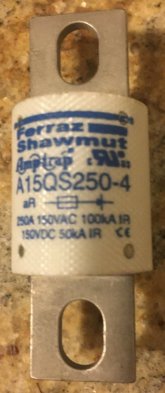Bluewatersailor
New Member
- Joined
- Nov 18, 2020
- Messages
- 58
I have a Chinese 3000W-6000w inverter in reality it never going to give me any thing like 3000w, batteries bank 400Ah .
am I correct in saying a 250A fused will be fine ? 3000/12v 250A
Also where best to fit the fuse, V+ next to the battery terminal? Or by the inverter?
The inverter came with 4 ( 2v+ 2v- ) 2/0 cables with one cable connector joining the cables together making two pairs,
the cables are 2 mts long which is much more then I need would it be better to shorten them or would the voltage drop within that size wire be fine .
If I can help it I rather not shorten them as they have a nice connection.
Thanks
am I correct in saying a 250A fused will be fine ? 3000/12v 250A
Also where best to fit the fuse, V+ next to the battery terminal? Or by the inverter?
The inverter came with 4 ( 2v+ 2v- ) 2/0 cables with one cable connector joining the cables together making two pairs,
the cables are 2 mts long which is much more then I need would it be better to shorten them or would the voltage drop within that size wire be fine .
If I can help it I rather not shorten them as they have a nice connection.
Thanks
Last edited:




